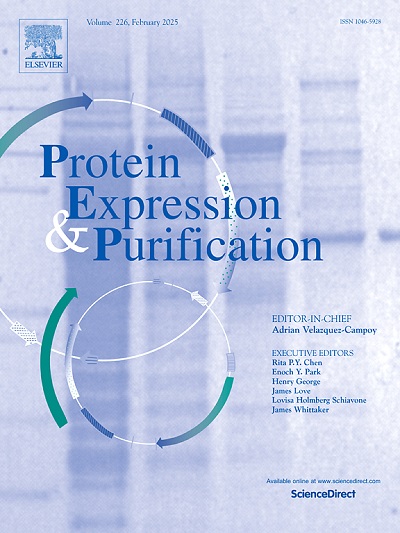一种能自组装成三螺旋和d -周期原纤维的新型人源胶原蛋白的合理设计和表征。
IF 1.2
4区 生物学
Q4 BIOCHEMICAL RESEARCH METHODS
引用次数: 0
摘要
三螺旋和d周期是天然胶原蛋白的显著特征,对其物理化学性质和生物活性至关重要。然而,开发具有d期特征的重组人源性胶原蛋白仍然难以捉摸。在这里,我们提出了一种利用具有自组装能力的“带电-疏水-带电氨基酸”序列制备新型重组人源性胶原蛋白的策略。中间区域的疏水氨基酸被认为对三螺旋的形成至关重要,而C端和n端的带电氨基酸驱动三螺旋自组装成高阶结构,如原纤维,在此过程中形成d周期。为了证明这一概念,我们选择并重复了人III型胶原Gly1059-Ala1103的特定片段,该片段具有精氨酸(R)、赖氨酸(K)、天冬氨酸(D)和谷氨酸(E)富集末端和甘氨酸-脯氨酸-丙氨酸(G-P-A)中心基序,构建了重组人源化胶原,命名为rhCL04。该结构成功地形成了分层结构,包括三螺旋、棒状原纤维和水凝胶,在4到10的广泛pH范围内表现出明显的10 nm d周期。此外,用L929小鼠成纤维细胞证实了细胞粘附和生物相容性,表明其能够促进细胞粘附活性,无明显的细胞毒性。我们的研究对天然胶原的自组装机制提供了有价值的见解。此外,这些结果强调了该策略在产生具有胶原样特征的重组人源性胶原蛋白方面的有效性。该方法的简单性和通用性,结合rhCL04优异的自组装特性和生物活性,强调了其在生物材料生产中的潜力。本文章由计算机程序翻译,如有差异,请以英文原文为准。

Rational designation and characterization of a novel humanized collagen capable of self-assembling into triple helix and fibrils with D-period
The triple helix and D-period are distinctive features of native collagen, crucial for its physicochemical properties and bioactivities. However, developing recombinant humanized collagen with D-period features remains elusive. Here, we present a strategy for preparing a novel recombinant humanized collagen using a ‘charged-hydrophobic-charged amino acid’ sequence with the capacity of self-assembling. The hydrophobic amino acids in the middle region are believed to be crucial for the triple helix formation while the charged amino acids at the C- and N-terminal drive the triple-helix to self-assemble into higher-order structures like fibrils, with D-period formation during this process. To prove this concept, the particular fragment of Gly1059-Ala1103 of human type III collagen, featuring arginine (R), lysine (K), aspartic acid (D), and glutamic acid (E)-rich termini and a Glycine-Proline-Alanine (G-P-A) central motif, was selected and repeated to construct a recombinant humanized collagen, designated as rhCL04. This construct successfully formed hierarchical structures, including triple helices, rod-like fibrils, and hydrogels, exhibiting a distinct 10 nm D-period across a broad pH range from 4 to 10. Additionally, cell adhesion and biocompatibility were confirmed using L929 mouse fibroblast cells, demonstrating the ability to promote cell adhesion activity and no significant cytotoxicity. Our study provides valuable insights into the self-assembling mechanisms of native collagens. Moreover, these results highlight the efficacy of this strategy in producing recombinant humanized collagen with collagen-like characteristics. The simplicity and versatility of the approach, combined with the excellent self-assembling properties and biological activity of rhCL04, underscore its potential for biomaterial production.
求助全文
通过发布文献求助,成功后即可免费获取论文全文。
去求助
来源期刊

Protein expression and purification
生物-生化研究方法
CiteScore
3.70
自引率
6.20%
发文量
120
审稿时长
32 days
期刊介绍:
Protein Expression and Purification is an international journal providing a forum for the dissemination of new information on protein expression, extraction, purification, characterization, and/or applications using conventional biochemical and/or modern molecular biological approaches and methods, which are of broad interest to the field. The journal does not typically publish repetitive examples of protein expression and purification involving standard, well-established, methods. However, exceptions might include studies on important and/or difficult to express and/or purify proteins and/or studies that include extensive protein characterization, which provide new, previously unpublished information.
 求助内容:
求助内容: 应助结果提醒方式:
应助结果提醒方式:


